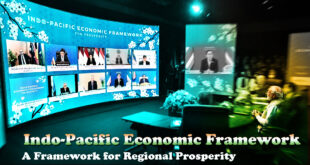Syllabus: Conservation, environmental pollution and degradation, environmental impact assessment.
Context
The occurrence of recent disasters such as landslides, rains, cloudbursts, and the subsidence in Joshimath in the Himalayan States has highlighted the imperative of prioritising environmental preservation over development.
The Himalayan mountain ranges
extend from the western region of Afghanistan to the eastern region of Myanmar
prominently India, China, and Pakistan – Rivers such as the Ganges, Indus, and Brahmaputra
The proposed action has the potential to increase the susceptibility of the already precarious and environmentally delicate area, exacerbating its vulnerability and rendering development more detrimental.
Argument 1-Development cannot come at the cost of environment
- approximately 70 ongoing or planned projects along the Ganga river
- The model was characterized as “bumper to bumper development”, wherein projects are undertaken in rapid succession without any gaps in between.
- According to scientific experts, the construction of dams on the Ganga river, encroachment on its riverbed, and mining operations in the area are causing significant detrimental effects on the region – state administrations lack of response to the request to halt construction activities and encroachment on the riverbed. A significant number of projects lack rigorous studies of their environmental and social impacts.
- There are numerous environmentally friendly alternatives available, such as the use of smoke from burning pine needles to drive turbines for electricity generation, biomass energy, and the implementation of micro hydro plants with a capacity to produce two MW of power. However, firms are not inclined to favour these less lucrative initiatives.
- Consequently, it is evident that the present environmental crisis is predominantly caused by human activities. The intricate equilibrium of natural forces has been perturbed and consequently, the Himalayan States are currently experiencing the consequences of this disruption.
Argument 2-Hydropower boon or Hydropower Curse?
- The inclusion of hydropower in India’s strategic plans is a subject of intense scholarly discourse. Jawaharlal Nehru, the first prime minister of independent India, emphasized dams as ‘temples of modern India.’ A professor specializing in environmental studies estimated 1,300 hydropower facilities have been constructed or are in the planning stages around the region.
- India is projected to experience a more rapid growth in energy demand in next twenty years – imperative for global emission reduction endeavors – secure alternative supplies – address the inherent variability of electricity generated by solar and wind sources.
- However, the extensive development of infrastructure in geologically unstable mountainous regions has generated significant controversy. An investigative committee constituted by the Supreme Court determined that the presence of hydropower dams exacerbated the disaster. Consequently, the committee cautioned against the construction of such dams in environmentally vulnerable regions situated at high altitudes. According to experts, authorities are engaging in a level of manipulation of the natural world that is beyond what is deemed appropriate.
- The proportion of hydropower in India’s electricity composition has experienced a decline, decreasing from 23% in the year 2000 to 12% in recent years. This reduction can be attributed to the substantial decrease in the cost of alternative sources, such as solar energy.
- The construction of roads, especially the Char Dham Highway has also been a subject of controversy. This endeavour is anticipated to attract pilgrims and visitors, hence fostering economic advantages. Additionally, it is expected to facilitate convenient military passage to India’s border with China. But the proposal is in opposition to earlier recommendations set by the road ministry, which discourage the construction of expansive highways in hilly regions.
Argument 3-Not only development but fraught geopolitics is also responsible
- A regrettable consequence has been the entanglement of climate and environmental concerns within the complex geopolitical dynamics of the region. The mountains serve as significant geopolitical boundaries across the globe.
- The 2,000-mile border between India and China, as well as the Line of Control that separates India and Pakistan in the region of Kashmir. The relationship between these neighbouring nations is characterised by tension, particularly in light of anticipated population and economic expansion, as well as the exacerbating effects of climate
- This is expected to heighten the struggle for shared resources, like water sourced from the Himalayan rivers.
- It is imperative for nations to establish a comprehensive, realistic, and non-partisan framework that addresses the long-term challenges pertaining to the survival of civilizations. An agreement was made by the eight nations in the Himalayan region to collaborate on climate action. However, it is widely argued that the effectiveness of collaboration and information exchange about matters such as river flows is impeded by strategic considerations and a sense of distrust.
- Several nations in the Himalayas experience persistent water scarcity. According to data from the World Bank, the United States possesses over 2.3 million gallons of renewable freshwater resources per individual annually. In contrast, China has 528,000 gallons, India has 264,000 gallons, and Pakistan has less than 79,000 gallons of renewable freshwater resources per person. The escalating demand for water to support the expansion of urban areas, agricultural activities, and industrial operations places further pressure on the rivers traversing these politically unstable regions.
Argument 4-If not trade off, then a fine line on development and conservation
- The presence of a vegetation cover in the surrounding valleys – serves as a protective barrier mitigating the adverse effects of climate change.
- Niti Aayog report – 2018 – potential depletion of around 60 percent of water sources in the Indian Himalayan area.
- Recommended that the upper stretch of Himalayan valleys be designated as an eco-sensitive zone (ESZ).
- The tourism industry – generates around eight million tonnes of garbage annually. Failure to handle solid waste disposal in a scientific manner – an urgent need for quick regulation of all operations.
- Tourism industry – generating economic resources, a significant portion of it is from religious sites, a crucial source of support for numerous individuals – but heightened levels of human waste and pollution, transportation activities, incessant proliferation of hotel construction and increasingly large-scale development initiatives – necessity of regulating the sector through a comprehensive scientific evaluation of the specific geographic area
 Chinmaya IAS Academy – Current Affairs Chinmaya IAS Academy – Current Affairs
Chinmaya IAS Academy – Current Affairs Chinmaya IAS Academy – Current Affairs



